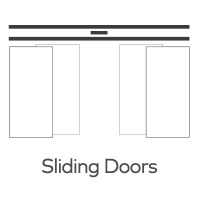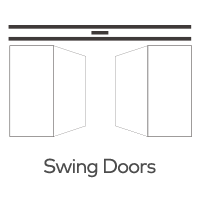Как работают датчики дверей и предупреждают ли они вас о движении?
Датчики дверей являются неотъемлемой частью современных систем безопасности, обеспечивающих удобство, эффективность и безопасность для домов, предприятий и других учреждений. Они предназначены для обнаружения наличия движения или изменения окружающей среды вокруг двери, вызывая действия, такие как открытие двери, отправка предупреждений или активация других систем. Хотя обычно используются в автоматических дверях, датчики дверей также играют жизненно важную роль в повышении безопасности путем обнаружения несанкционированного доступа. В этой статье мы рассмотрим, как работают датчики дверей и могут ли они предупредить вас о движении.

1. Типы датчиков дверей
Прежде чем погрузиться в то, как работают датчики дверей, важно понять различные типы датчиков, обычно используемые в системах автоматизации дверей:
- Инфракрасные датчики (пассивные инфракрасные или PIR): Эти датчики обнаруживают изменения в инфракрасном излучении, вызванные теплом, излучаемым человеческим телом или другими теплыми объектами. Датчики PIR обычно используются в автоматических дверях и системах безопасности для обнаружения движения. Они очень чувствительны к движению, что делает их идеальными для сред, где людям может потребоваться входить или выходить без ручного управления дверью.
- Ультразвуковые датчики: Ультразвуковые датчики используют звуковые волны для обнаружения присутствия объектов или людей. Эти датчики отправляют ультразвуковые волны, и когда волны отскачают от объекта и возвращаются, датчик может измерить расстояние до этого объекта. Если расстояние меняется из-за движения, датчик запускает дверь для открытия или отправляет предупреждение.
- Магнитные датчики: Эти датчики обычно используются в дверях безопасности, где между двумя компонентами создается магнитное поле - один закреплен на дверной раме, а другой на самой двери. Когда дверь открывается, магнитное поле прерывается, запуская датчик для обнаружения открытия.
- Лазерные датчики: Лазерные датчики дверей используют луч света для обнаружения объектов или людей, пересекающих их путь. Эти датчики часто используются в зонах высокой безопасности и автоматических дверях, обеспечивая точное и быстрое обнаружение.
- Маты под давлением: Часто используются в коммерческих или промышленных дверях, маты под давлением размещаются на земле под или рядом с дверью. Когда применяется давление, например, когда человек ступает на мат, датчик запускает дверь для открытия.
2. Как работают датчики дверей?
Работа датчиков дверей основана на их способности обнаруживать физические изменения в их окружающей среде. Вот разбивка того, как работают некоторые из распространенных типов датчиков:
- Инфракрасные датчики (PIR): Пассивные инфракрасные датчики обнаруживают инфракрасное излучение, излучаемое живыми телами (такими как люди или животные). Эти датчики являются пассивными, потому что они сами не излучают инфракрасное излучение; скорее, они чувствуют инфракрасное излучение, поступающее от объектов в их поле зрения. Когда человек проходит мимо датчика, датчик воспринимает изменение инфракрасного излучения, которое интерпретируется как движение. Затем датчик посылает сигнал дверной системе, указывая ей открыть. Они предупреждают вас о движении? Датчики PIR, как правило, предназначены для того, чтобы запустить дверь, чтобы открыться, а не обязательно предупредить вас напрямую. Однако некоторые системы безопасности, интегрированные с датчиками PIR, могут отправлять уведомления (например, электронные письма или предупреждения приложений), если обнаружено движение, особенно в приложениях безопасности.
- Ультразвуковые датчики: Ультразвуковые датчики работают, испуская высокочастотные звуковые волны и измеряя, сколько времени требуется, чтобы звук отскочил после удара по объекту. Когда происходит движение, оно меняет способ движения звуковых волн. Датчик рассчитывает изменение расстояния, и на основе этого он может запустить такие действия, как открытие двери или предупреждение системы мониторинга. Они предупреждают вас о движении? Как и датчики PIR, ультразвуковые датчики обычно используются для открытия дверей или активации систем. В передовых настройках они могут быть интегрированы в более крупные системы безопасности, которые отправляют предупреждения, когда обнаружено неожиданное движение.
- Магнитные датчики: Магнитные датчики опираются на принцип магнитизма для обнаружения состояния двери. Магнитное поле создается, когда дверь закрыта. Когда дверь открывается, датчик обнаруживает разрыв в магнитном поле, вызывая действие системы автоматизации двери. Они предупреждают вас о движении? Хотя магнитные датчики в основном обнаруживают открытие и закрытие дверей, они могут быть интегрированы в системы безопасности, которые отправляют уведомления, когда дверь открывается или манипулируется.
- Лазерные датчики: Лазерные датчики испускают луч света, обычно в прямой линии, и если объект (как человек) пересекает луч, датчик обнаруживает перерыв и может вызвать ответ. Они предупреждают вас о движении? Лазерные датчики очень чувствительны и могут предупредить вас о движении, если система настроена с функцией мониторинга. Они часто используются в приложениях высокой безопасности, где о любых нарушениях в луче датчика необходимо немедленно сообщать.
- Маты под давлением: Маты под давлением обнаруживают физическое давление, такое как вес человека или транспортного средства. Когда человек ступает на мат, датчик обнаруживает изменение давления и вызывает открытие двери. Они предупреждают вас о движении? Хотя маты под давлением обычно предназначены для запуска действия двери, они могут быть подключены к системе сигнализации, которая предупреждает вас, когда происходит неожиданная деятельность или несанкционированный доступ.







